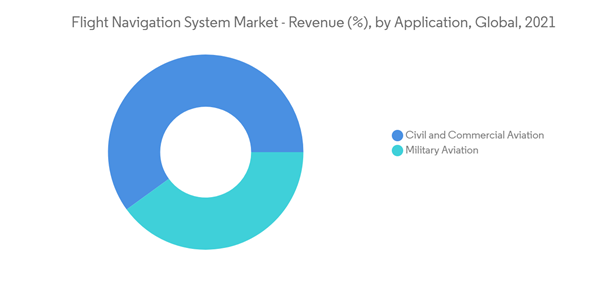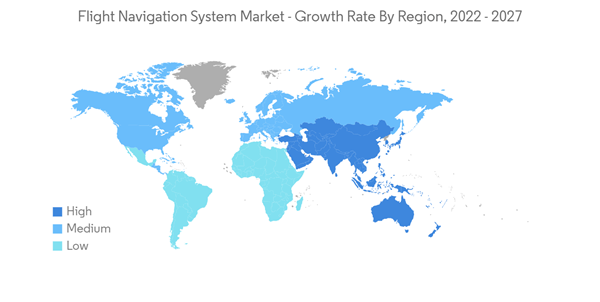The flight navigation system market is anticipated to witness a CAGR of above 6% during the forecast period (2022 - 2027)
The outbreak of COVID-19 has massively impacted the growth of the market. For most of 2020, most international flights were grounded, and domestic flights were operating at half their capacity. Although the situation improved in 2021, the traffic was well below the pre-pandemic levels. This has forced several airlines to postpone their aircraft procurement plans in the commercial sector, thereby hindering market growth.
Moreover, the increasing procurements of aircraft in the general aviation sector, along with the rebound in passenger traffic and increasing military spending of several countries globally, are anticipated to drive the growth of the market during the forecast period.
The mandates made by the regulatory bodies of commercial aviation are making the airlines integrate advanced systems in their fleet to create safe and efficient airspace. For instance, the FAA mandated the use of ADS-B Out on the aircraft operating in most controlled US airspace by January 2020. Such regulations may propel the demand for flight navigation systems during the forecast period.
The development of advanced autonomous aircraft and regional satellite navigation systems is anticipated to boost the growth of the flight navigation systems market in the future.
This product will be delivered within 2 business days.
The outbreak of COVID-19 has massively impacted the growth of the market. For most of 2020, most international flights were grounded, and domestic flights were operating at half their capacity. Although the situation improved in 2021, the traffic was well below the pre-pandemic levels. This has forced several airlines to postpone their aircraft procurement plans in the commercial sector, thereby hindering market growth.
Moreover, the increasing procurements of aircraft in the general aviation sector, along with the rebound in passenger traffic and increasing military spending of several countries globally, are anticipated to drive the growth of the market during the forecast period.
The mandates made by the regulatory bodies of commercial aviation are making the airlines integrate advanced systems in their fleet to create safe and efficient airspace. For instance, the FAA mandated the use of ADS-B Out on the aircraft operating in most controlled US airspace by January 2020. Such regulations may propel the demand for flight navigation systems during the forecast period.
The development of advanced autonomous aircraft and regional satellite navigation systems is anticipated to boost the growth of the flight navigation systems market in the future.
Key Market Trends
Civil and Commercial Aviation Segment to Experience the Highest Growth During the Forecast Period
The market's civil and commercial aviation segment currently has the largest share and is expected to register the highest CAGR during the forecast period. The major driver for the segment is the growing orders and deliveries of commercial aircraft that are generating demand for new and advanced navigation and control systems for aircraft. Airbus and Boeing recorded 611 and 340 deliveries in 2021 and are expected to deliver 702 and 450 commercial jets in 2022. Another major growth factor is the mandated regulations by the regulatory bodies of commercial aviation, which are making the airlines integrate advanced systems for safety purposes. The development of new systems, like ACAS X, may further boost the growth of the segment during the forecast period. Government mandates aimed at enhancing flight safety are also expected to drive the growth of the segment. For instance, while Automatic Dependent Surveillance-Broadcast (ADS-B) Out has been mandatory in certain U.S. airspace for two years, Canada opted to delay a similar mandate pending trial runs until early 2022. However, in February 2022, NAV CANADA announced it will implement a new mandate that will require aircraft operators flying in certain domestic airspace to meet ADS-B Out Performance Requirements. The mandate will come into effect in Class A and B Canadian airspace above 12,500 feet on February 23, 2023. Such mandates will drive the implementation of new generation flight navigation systems, thereby driving the growth of the segment during the forecast period.Asia-Pacific is Expected to Generate the Highest Demand During the Forecast Period
The Asia-Pacific region is expected to generate the highest demand for the flight navigation system market during the forecast period. This growth in the market is due to the growing commercial and military aircraft fleet in the region. China and India lead the civil and commercial aviation industry in the region, followed by Japan, Australia, South Korea, Indonesia, and the Philippines. There are huge aircraft order backlogs in various countries for various commercial aircraft manufactured by Airbus and Boeing, which may drive the demand for flight navigation systems in this region. Also, there has been a growing demand for new military aircraft from the Asia-Pacific region as major countries look to modernize their fleet and increase their capabilities. Countries in the region have also inducted several new military aircraft into their fleets over the past few years and are expected to continue to do so, driven by their colossal defense budgets. Also, the under development and newly launched aircraft projects, like COMAC C919 and C929, Mitsubishi SpiceJet (MRJ), KAI KF-X (IA IF-X), J-31, and AG600, are anticipated to generate demand for newer generation navigation systems for the aircraft platforms from the country in the years to come.Competitive Landscape
The flight navigation system market is fragmented, with many suppliers providing various instruments, like antennas, gyroscopes, altimeters, and sensors. Some prominent players in the flight navigation system market are Collins Aerospace (Raytheon Technologies Corporation), Honeywell International Inc., Northrop Grumman Corporation, Garmin Ltd, and Thales Group. Collins Aerospace and Honeywell International Inc. are two major companies that offer aircraft navigation aids to commercial segments. On the other hand, BAE Systems PLC, Raytheon Company, and Northrop Grumman Corporation, among others, are some of the prominent companies that provide navigation equipment to military aircraft. The development of new and advanced positioning systems to accurately locate and navigate the aircraft to its destinations is anticipated to support the companies' long-term growth. However, the faulty parts and components manufactured by the companies have recently led to accidents and risks to the lives of people on board aircraft. Such situations may hamper the partnerships of the OEMs and component or system providers, thereby hindering their growth.Additional Benefits:
- The market estimate (ME) sheet in Excel format
- 3 months of analyst support
This product will be delivered within 2 business days.
Table of Contents
1 INTRODUCTION
4 MARKET DYNAMICS
5 MARKET SEGMENTATION (Market Size and Forecasts by Value - USD million, 2018 - 2027)
6 COMPETITIVE LANDSCAPE
Companies Mentioned (Partial List)
A selection of companies mentioned in this report includes, but is not limited to:
- Collins Aerospace (Raytheon Technologies Corporation)
- Honeywell International Inc.
- Northrop Grumman Corporation
- Garmin Ltd
- Thales Group
- Cobham PLC
- CMC Electronics Inc.
- Safran SA
- BAE Systems PLC
- L3 Harris Technologies
- General Electric Company*
Methodology

LOADING...










